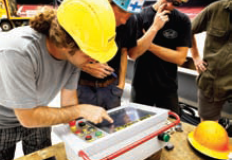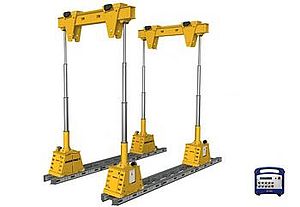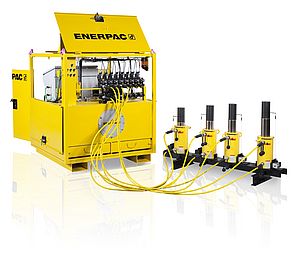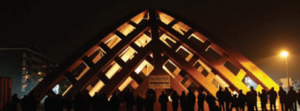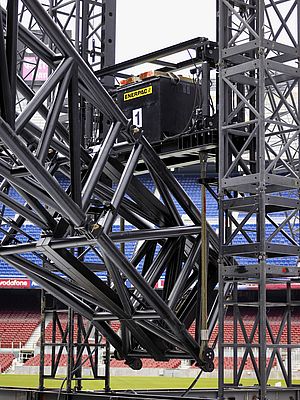The Belgian company Stageco has constructed three gigantic, identical stages for the current U2 360° Tour. High-pressure hydraulics are being used for the rst time ever to assemble and dismantle the 230 ton construction - also known as “the claw”. Together with Enerpac, Stageco has developed a unique system, based on the Synchronous Lift System, to raise the modular construction to a height of 30 metres quickly and safely.
Being able to put on bigger and better shows than your competitors gives you a trump card in the entertainment world. Performances and tours by famous artists and bands have to look good, as is demonstrated by the glitz and special e- ects that are usually the main feature. The stage is crucial, and this is no di- erent in U2’s 360° Tour. For this world tour, set designer Willy Williams and stage architect Mark Fisher came up with “the claw”, a 30 metre high stage construction on four legs, giving spectators all around the stage an unobstructed view of the band.
Leap frogging
Stageco, a specialist company based in Tildonk, Belgium, was contacted for the construction of the stage. This was not the rst time – Stageco also designed and built the stages for one of U2’s previous tours, the PopMart Tour in 1997. Stageco is a market leader and primarily sets itself apart through customisation. Over the years, the company has built stages for tours by artists such as the Rolling Stones, Bon Jovi, Tina Turner, Elton John and Johnny Hallyday. Stageco provides a complete package, from technical design and manufacture, right up to logistics. Since there is only a relatively short time between performances and a total of 7 to 8 days are needed to assemble and dismantle the stage construction, three whole stages have been constructed, which are used following the “leap frogging” principle: one is used for the show, whilst the second is already being built at the next location and the third is being dismantled at the previous location.
Speed
One of the construction requirements was that the stage could be built and taken down again in a relatively short time. The challenge for Stageco was therefore how to assemble and dismantle the massive 230 ton construction each time. Logistics naturally also needed to be considered and a solution had to be found for the installation of the technics (light and sound) and the special 60 ton video screen that also had to be raised and lowered each time. Chain hoists and winches are normally used for stages, with the support of relatively light mobile cranes where required. However, the load in this project was so great that a different solution was called for.
One of the alternatives considered was the use of extremely heavy mobile cranes with a lifting capacity of at least 400 to 500 tons. However, there was doubt as to whether such cranes would t inside the stadiums where the concerts were due to take place and whether they could be stabilised su ciently. The use of such cranes is also very expensive. Another alternative was a temporary hoisting construction and the use of hydraulics, for example, hydraulic strand jacks. Stageco eventually joined up with Enerpac as a customisation-oriented partner. The requirement was that the system had to be more or less plug and play. A ready to- use hydraulic unit was required that would only need to be connected to the electricity supply and the operating computer. Together, the two companies came up with a highly effective solution which incorporated custom designed Synchronous Lift System to use highpressure hydraulics for the rst time ever for such heavy loads.
Gradual lifting
The steel stage construction consists of a central “block” which rests upon four legs, each made up of six sections. The central block is gradually lifted o- the ground in 38 steps and a section is added to each of the four legs after every 6 or 7 steps.
A temporary truss (lifting portal) containing a supporting frame at the top has been made for each leg. Within each truss, a hydraulic pump unit, four high-pressure lifting cylinders (350 bar), each with an applied pulling force of 20 tons (200 kN) and a 600mm stroke, and four 0.5 ton low-pressure (60 bar) locking cylinders, each with a stroke of 260mm, are all attached to a supporting frame, which moves along the guide rails. The complete hoisting system for each stage therefore consists of 16 lifting cylinders, 16 locking cylinders and 4 fully hydraulic units.
The lifting cylinders are fitted with a pressure transducer, a built-in stroke sensor and two proximity switches. The locking cylinders are also tted with two proximity switches. The hydraulic pump unit includes individual pumps - one for the lifting cylinders and one for the locking cylinders. The pump units are controlled according to the master/slave principle from a central operating computer on the ground, which has a touch screen with images showing the position of the various hydraulic cylinders and their position within the lifting portals. The force of each lifting cylinder and each lifting portal is also displayed, along with the total force. A local PLC has been installed on each platform so that the lifting platform can be operated locally if necessary.
Up and down
First of all, the complete pump units are positioned in the lifting portals using a small mobile crane. At the beginning of the lifting process, the ends of the central block rest on the supporting frames with the units. When the frame is lifted, the top beams are rst raised one step hydraulically, and then locked mechanically using locking pins and the hydraulic locking cylinders. The bottom locking pins are then cleared hydraulically and the cylinders raise the load to the same height. In this way, the four hydraulic units lift themselves in the lifting portals with the load, as it were, at a net speed of around 10m per hour.
Lift synchronism is vital here due to the torsional stress that occurs. Stageco works with a tolerance of 5 to 10mm. This may seem like a lot, but it is adequate since the lifting portals are 35 metres apart. The operating computer’s display also shows that the load in the four portals remains in perfect balance. The display shows which steps in the lifting process have already been completed. The operator does, however, need to give a command for each step. After the claw has been assembled, the pump units are lifted out of the lifting portals with a crane, and the lifting portals are then removed. The system works according to the same principle but, of course, in the opposite direction when the whole construction is later lowered and dismantled. The pump units are then back on the ground and can be stored ready for transport to the next location.
Safety trump card
Stageco has made no concessions whatsoever as far as safety is concerned. The mechanical locking of the lifting platforms, for example, was an extremely important element. The computer-controlled Synchronous Lift System also ful lled this requirement.
Every step in the lifting process is controlled, and the next step can only be performed when all the required conditions have been ful lled. The system also gives information on the position the load is in and how the tension is distributed during lifting. The system measures the forces continuously and in real time. Although the operational speed is signi cant, Stageco considers safety to be one of the greatest advantages of this technology. Since the three stages will be travelling across the whole world over the next two years, the emphasis is also on reliability and durability. According to Stageco, another advantage is that Enerpac has an international presence and operates worldwide.
It is clear that shows will continue to get bigger and better in the entertainment world. Since Stageco now has this new technology in house, set designers will also have much more freedom and it will be possible to build spectacular stages at many more locations. In short, this is a technological step that is setting a new trend.



